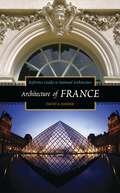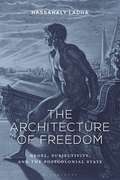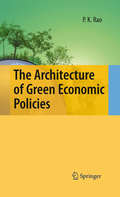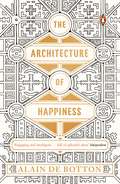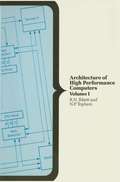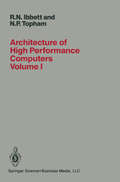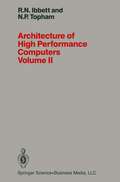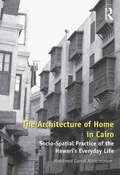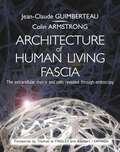- Table View
- List View
Architecture of First Societies: A Global Perspective
by Mark M. Jarzombek“This book is the most comprehensively global and critically sensitive synthesis of what we now know of the material and socio-cultural evolution of the so-called First Societies. Written by a distinguished architectural historian and theorist, this truly remarkable and indispensable study shows how the material culture of our forebears, from building to clothing, food, ritual and dance, was inextricably bound up with the mode of survival obtained in a particular place and time…It is a study that will surely become required reading for every student of material culture.”—Kenneth Frampton Starting with the dawn of human society, through early civilizations, to the pre-Columbian American tribes, Architecture of First Societies: A Global Perspective traces the different cultural formations that developed in various places throughout the world to form the built environment. Looking through the lens of both time and geography, the history of early architecture is brought to life with full-color photographs, maps, and drawings. Drawing on the latest research in archaeological and anthropological knowledge, this landmark book also looks at how indigenous societies build today in order to help inform the past.
Architecture of France (Reference Guides to National Architecture)
by David A. HanserCovering all regions of France—from Avignon's Palace of the Popes to Versailles' Petit Trianon—and all periods of French architecture—from the Roman theater at Orange to the Arc de Triomphe in Paris—this volume examines more than 60 of France's most important architectural landmarks. Writing in a clear and engaging style, David Hanser, professor of architecture at Oklahoma State University, describes the features, functions, and historical importance of each structure. Besides identifying location, style, architects, and periods of initial construction and major renovation, the cross-referenced and illustrated entries also highlight architectural and historical terms explained in the Glossary and conclude with a useful listing of further readings. The volume also offers ready-reference lists of entries by location, architectural style, and time period, as well as a general bibliography, a subject index, and a detailed introductory overview of French architecture.Entries cover major architectural structures as well as smaller sites, including everything from the Cathedral of Notre Dame to Metro (subway) stations. Ideal for college and high school students alike, this comprehensive look at the architecture of France is an indispensible addition to any shelf.
The Architecture of Frank Lloyd Wright, Fourth Edition: A Complete Catalog
by William Allin StorrerFrom sprawling houses to compact bungalows and from world-famous museums to a still-working gas station, Frank Lloyd Wright’s designs can be found in nearly every corner of the country. While the renowned architect passed away more than fifty years ago, researchers and enthusiasts are still uncovering structures that should be attributed to him. William Allin Storrer is one of the experts leading this charge, and his definitive guide, The Architecture of Frank Lloyd Wright, has long been the resource of choice for anyone interested in Wright. Thanks to the work of Storrer and his colleagues at the Rediscovering Wright Project, thirty-seven new sites have recently been identified as the work of Wright. Together with more photos, updated and expanded entries, and a new essay on the evolution of Wright’s unparalleled architectural style, this new edition is the most comprehensive and authoritative catalog available. Organized chronologically, the catalog includes full-color photos, location information, and historical and architectural background for all of Wright’s extant structures in the United States and abroad, as well as entries for works that have been demolished over the years. A geographic listing makes it easy for traveling Wright fans to find nearby structures and a new key indicates whether a site is open to the public. Publishing for Wright’s sesquicentennial, this new edition will be a trusted companion for anyone embarking on their own journeys through the wonder and genius of Frank Lloyd Wright.
The Architecture of Frank Lloyd Wright, Fourth Edition: A Complete Catalog
by William Allin StorrerFrom sprawling houses to compact bungalows and from world-famous museums to a still-working gas station, Frank Lloyd Wright’s designs can be found in nearly every corner of the country. While the renowned architect passed away more than fifty years ago, researchers and enthusiasts are still uncovering structures that should be attributed to him. William Allin Storrer is one of the experts leading this charge, and his definitive guide, The Architecture of Frank Lloyd Wright, has long been the resource of choice for anyone interested in Wright. Thanks to the work of Storrer and his colleagues at the Rediscovering Wright Project, thirty-seven new sites have recently been identified as the work of Wright. Together with more photos, updated and expanded entries, and a new essay on the evolution of Wright’s unparalleled architectural style, this new edition is the most comprehensive and authoritative catalog available. Organized chronologically, the catalog includes full-color photos, location information, and historical and architectural background for all of Wright’s extant structures in the United States and abroad, as well as entries for works that have been demolished over the years. A geographic listing makes it easy for traveling Wright fans to find nearby structures and a new key indicates whether a site is open to the public. Publishing for Wright’s sesquicentennial, this new edition will be a trusted companion for anyone embarking on their own journeys through the wonder and genius of Frank Lloyd Wright.
The Architecture of Frank Lloyd Wright, Fourth Edition: A Complete Catalog
by William Allin StorrerFrom sprawling houses to compact bungalows and from world-famous museums to a still-working gas station, Frank Lloyd Wright’s designs can be found in nearly every corner of the country. While the renowned architect passed away more than fifty years ago, researchers and enthusiasts are still uncovering structures that should be attributed to him. William Allin Storrer is one of the experts leading this charge, and his definitive guide, The Architecture of Frank Lloyd Wright, has long been the resource of choice for anyone interested in Wright. Thanks to the work of Storrer and his colleagues at the Rediscovering Wright Project, thirty-seven new sites have recently been identified as the work of Wright. Together with more photos, updated and expanded entries, and a new essay on the evolution of Wright’s unparalleled architectural style, this new edition is the most comprehensive and authoritative catalog available. Organized chronologically, the catalog includes full-color photos, location information, and historical and architectural background for all of Wright’s extant structures in the United States and abroad, as well as entries for works that have been demolished over the years. A geographic listing makes it easy for traveling Wright fans to find nearby structures and a new key indicates whether a site is open to the public. Publishing for Wright’s sesquicentennial, this new edition will be a trusted companion for anyone embarking on their own journeys through the wonder and genius of Frank Lloyd Wright.
The Architecture of Frank Lloyd Wright, Fourth Edition: A Complete Catalog
by William Allin StorrerFrom sprawling houses to compact bungalows and from world-famous museums to a still-working gas station, Frank Lloyd Wright’s designs can be found in nearly every corner of the country. While the renowned architect passed away more than fifty years ago, researchers and enthusiasts are still uncovering structures that should be attributed to him. William Allin Storrer is one of the experts leading this charge, and his definitive guide, The Architecture of Frank Lloyd Wright, has long been the resource of choice for anyone interested in Wright. Thanks to the work of Storrer and his colleagues at the Rediscovering Wright Project, thirty-seven new sites have recently been identified as the work of Wright. Together with more photos, updated and expanded entries, and a new essay on the evolution of Wright’s unparalleled architectural style, this new edition is the most comprehensive and authoritative catalog available. Organized chronologically, the catalog includes full-color photos, location information, and historical and architectural background for all of Wright’s extant structures in the United States and abroad, as well as entries for works that have been demolished over the years. A geographic listing makes it easy for traveling Wright fans to find nearby structures and a new key indicates whether a site is open to the public. Publishing for Wright’s sesquicentennial, this new edition will be a trusted companion for anyone embarking on their own journeys through the wonder and genius of Frank Lloyd Wright.
The Architecture of Freedom: Hegel, Subjectivity, and the Postcolonial State
by Hassanaly LadhaPositioned at the intersection of philosophy and African studies, this book identifies Hegel's “Africa” as a fluid, utopic space enabling the traversal of the East-West binary. As Hegel's figure for the non-historical, Africa marks the negativity that propels the movement of the dialectic in time. Mirroring the “shrouded” continent's relation to history, Kantian “architectonics” step out of the realm of logic in Hegelian thought and drive the historical unfolding of the aesthetic. In a foundational move, Hegel hypostatizes the aesthetic entanglement of built and linguistic form as the colossus of Memnon, an African warrior memorialized in ancient architecture, myth, and art. Reaching for freedom, the Memnon marks the architectonic modality through which the African slave, at the telos of history, will fulfill the spiritual promise of the human and bring about the politically mature state. The book examines the syncretic figure of the Memnon and slave across Hegel's lecture courses, the Phenomenology of Spirit, the Encyclopedia, and the Philosophy of Right, offering a new reading of his related theories of language and the aesthetic, mastery and servitude, and subjectivity and the state and calling for a reassessment of these concepts in African studies and other philosophically informed disciplines. This book will be of interest to scholars in philosophy, postcolonial and African studies, political theory, architecture, and historiography.
The Architecture of Freedom: Hegel, Subjectivity, and the Postcolonial State
by Hassanaly LadhaPositioned at the intersection of philosophy and African studies, this book identifies Hegel's “Africa” as a fluid, utopic space enabling the traversal of the East-West binary. As Hegel's figure for the non-historical, Africa marks the negativity that propels the movement of the dialectic in time. Mirroring the “shrouded” continent's relation to history, Kantian “architectonics” step out of the realm of logic in Hegelian thought and drive the historical unfolding of the aesthetic. In a foundational move, Hegel hypostatizes the aesthetic entanglement of built and linguistic form as the colossus of Memnon, an African warrior memorialized in ancient architecture, myth, and art. Reaching for freedom, the Memnon marks the architectonic modality through which the African slave, at the telos of history, will fulfill the spiritual promise of the human and bring about the politically mature state. The book examines the syncretic figure of the Memnon and slave across Hegel's lecture courses, the Phenomenology of Spirit, the Encyclopedia, and the Philosophy of Right, offering a new reading of his related theories of language and the aesthetic, mastery and servitude, and subjectivity and the state and calling for a reassessment of these concepts in African studies and other philosophically informed disciplines. This book will be of interest to scholars in philosophy, postcolonial and African studies, political theory, architecture, and historiography.
The Architecture of Full-Scale Mock-Ups: From Representation to Reality
by Nick GelpiThe Architecture of Full-Scale Mock-Ups looks at the theory and contemporary practice of creating full-scale architectural mock-ups. This book serves as an introduction to the various forms of full-scale mock-ups which occur today. To broaden the definition of mock-ups, Nick Gelpi dives deep into the use of mock-ups in seven high-profile and global contemporary case studies. Instead of the presentation drawings and final building photos, the documentation of case studies relies on process photos, interviews, and moments of tension in the execution of each building. With never-before-published content, case studies include buildings from all over the world, including the Quincho Tia Coral and Teleton Building, Copper House II, the Pérez Art Museum Miami, the Cité de l’Océan et du Surf Museum, and more. Investigating unique case studies to answer how and when full-scale mock-ups occur today, this book is ideal for professionals and students of architecture studying materials and representation, design-build, and professional practice.
The Architecture of Full-Scale Mock-Ups: From Representation to Reality
by Nick GelpiThe Architecture of Full-Scale Mock-Ups looks at the theory and contemporary practice of creating full-scale architectural mock-ups. This book serves as an introduction to the various forms of full-scale mock-ups which occur today. To broaden the definition of mock-ups, Nick Gelpi dives deep into the use of mock-ups in seven high-profile and global contemporary case studies. Instead of the presentation drawings and final building photos, the documentation of case studies relies on process photos, interviews, and moments of tension in the execution of each building. With never-before-published content, case studies include buildings from all over the world, including the Quincho Tia Coral and Teleton Building, Copper House II, the Pérez Art Museum Miami, the Cité de l’Océan et du Surf Museum, and more. Investigating unique case studies to answer how and when full-scale mock-ups occur today, this book is ideal for professionals and students of architecture studying materials and representation, design-build, and professional practice.
The Architecture of Fundamental Rights in the European Union (Modern Studies in European Law)
by Šejla ImamovicThis book analyses the new architecture for the protection of fundamental rights in Europe after the entry into force of the Lisbon Treaty. As a starting point, it identifies how the EU has gained a prominent role in promoting and protecting fundamental rights at European level despite the absence of an unlimited mandate to address fundamental rights violations. This new setting affects the traditional relationship between the EU, the ECHR system and the Member States and, in the absence of EU accession to the ECHR, enhances the risk of tensions and conflicts between the case law of the two European Courts. Examples of these tensions and conflicts are explored in the Area of Freedom Security and Justice, which is one of the most fundamental rights-sensitive areas of EU law and one of the busiest areas of activity for the CJEU. The book offers new insights into existing rules on the resolution of conflicts between EU and ECHR law before mapping out techniques actually used by domestic courts to avoid or address such conflicts.
The Architecture of Fundamental Rights in the European Union (Modern Studies in European Law)
by Šejla ImamovicThis book analyses the new architecture for the protection of fundamental rights in Europe after the entry into force of the Lisbon Treaty. As a starting point, it identifies how the EU has gained a prominent role in promoting and protecting fundamental rights at European level despite the absence of an unlimited mandate to address fundamental rights violations. This new setting affects the traditional relationship between the EU, the ECHR system and the Member States and, in the absence of EU accession to the ECHR, enhances the risk of tensions and conflicts between the case law of the two European Courts. Examples of these tensions and conflicts are explored in the Area of Freedom Security and Justice, which is one of the most fundamental rights-sensitive areas of EU law and one of the busiest areas of activity for the CJEU. The book offers new insights into existing rules on the resolution of conflicts between EU and ECHR law before mapping out techniques actually used by domestic courts to avoid or address such conflicts.
The Architecture Of Global Governance: An Introduction To The Study Of International Organizations (PDF)
by James P Muldoon Jr.In our world of massive and rapid change, international organizations are at the vanguard of a worldwide movement to build a new world order based on the principles of global governance. The international system established in the wake of World War II is coming undone, argues James Muldoon, and the cornerstones of 20th century international relations--the Westphalian nation-state system, the Wilsonian principles of collective security and self-determination, and the faith in technological and scientific progress--are being undermined by the forces of globalization and fragmentation that characterize the post-Cold War world. At center stage of this dramatic transition to a new global order is a throng of international organizations which must contend with the increasing disarray of international relations and still manage the many latent and new problems on the international agenda. Muldoon skillfully guides the uninitiated through the tangled world of international organizations, pointing out along the way important events and key factors which have shaped their creation and evolution. This new and timely textbook makes the esoteric subject of international organizations accessible and very engaging for a new generation of students and scholars. Appraising the dynamics of systemic transformation and the challenges posed by expanding global interdependence, The Architecture of Global Governance puts international organizations in their proper context and restores the study of international organizations as a vibrant and critical field of contemporary international relations.
The Architecture Of Global Governance: An Introduction To The Study Of International Organizations
by James P Muldoon, Jr.A beautifully illustrated textbook of the history, theory and current state of international organizations which increasingly oversee aspects of international affairs and the world's transition to a new global order.. This new and timely textbook recounts the historical and theoretical development of the international system in a lively analysis o
Architecture of Great Expositions 1937-1959: Messages of Peace, Images of War (Ashgate Studies in Architecture)
by Alexander Ortenberg Rika DevosThis book investigates architecture as a form of diplomacy in the context of the Second World War at six major European international and national expositions that took place between 1937 and 1959. The volume gives a fascinating account of architecture assuming the role of the carrier of war-related messages, some of them camouflaged while others quite frank. The famous standoffs between the Stalinist Russia and the Nazi Germany in Paris 1937, or the juxtaposition of the USSR and USA pavilions in Brussels 1958, are examples of very explicit shows of force. The book also discusses some less known - and more subtle - messages, revealed through an examination of several additional pavilions in both Paris and Brussels; of a series of expositions in Moscow; of the Universal Exhibition in Rome that was planned to open in 1942; and of London’s South Bank Exposition of 1951: all of them related, in one way or another, to either an anticipation of the global war or to its horrific aftermaths. A brief discussion of three pre-World War II American expositions that are reviewed in the Epilogue supports this point. It indicates a significant difference in the attitude of American exposition commissioners, who were less attuned to the looming war than their European counterparts. The book provides a novel assessment of modern architecture’s involvement with national representation. Whether in the service of Fascist Italy or of Imperial Japan, of Republican Spain or of the post-war Franquista regime, of the French Popular Front or of socialist Yugoslavia, of the arising FRG or of capitalist USA, of Stalinist Russia or of post-colonial Britain, exposition architecture during the period in question was driven by a deep faith in its ability to represent ideology. The book argues that this widespread confidence in architecture’s ability to act as a propaganda tool was one of the reasons why Modernist architecture lent itself to the service of such different masters.
Architecture of Great Expositions 1937-1959: Messages of Peace, Images of War (Ashgate Studies in Architecture)
by Alexander Ortenberg Rika DevosThis book investigates architecture as a form of diplomacy in the context of the Second World War at six major European international and national expositions that took place between 1937 and 1959. The volume gives a fascinating account of architecture assuming the role of the carrier of war-related messages, some of them camouflaged while others quite frank. The famous standoffs between the Stalinist Russia and the Nazi Germany in Paris 1937, or the juxtaposition of the USSR and USA pavilions in Brussels 1958, are examples of very explicit shows of force. The book also discusses some less known - and more subtle - messages, revealed through an examination of several additional pavilions in both Paris and Brussels; of a series of expositions in Moscow; of the Universal Exhibition in Rome that was planned to open in 1942; and of London’s South Bank Exposition of 1951: all of them related, in one way or another, to either an anticipation of the global war or to its horrific aftermaths. A brief discussion of three pre-World War II American expositions that are reviewed in the Epilogue supports this point. It indicates a significant difference in the attitude of American exposition commissioners, who were less attuned to the looming war than their European counterparts. The book provides a novel assessment of modern architecture’s involvement with national representation. Whether in the service of Fascist Italy or of Imperial Japan, of Republican Spain or of the post-war Franquista regime, of the French Popular Front or of socialist Yugoslavia, of the arising FRG or of capitalist USA, of Stalinist Russia or of post-colonial Britain, exposition architecture during the period in question was driven by a deep faith in its ability to represent ideology. The book argues that this widespread confidence in architecture’s ability to act as a propaganda tool was one of the reasons why Modernist architecture lent itself to the service of such different masters.
The Architecture of Green Economic Policies
by P.K. RaoAfter numerous scienti?c papers and books on most aspects of climate change and the design of pro-environmental policies (including some that suit some industrial lobby or another), is there relevance for another book and what is the purported role of this one? Is this yet another academic exercise or “much ado about nothing”? Do we have to bother designing green economic policies and incur transaction costs of this effort? Are there shortcomings of existing policies if we care to live “happily” on this planet? Is it not enough to care for the current generations so that the future generations can take care of themselves (or even be given the incentives for in- vations – for lack of fully provided resources)? What can “we” do about the green economic policies (and what are these anyway)? What trade-offs, if any, are re- vant in foregoing some bene?ts and in incurring some costs (not all of which can be expressed in monetary units)? What are the overarching objectives and priorities in the current context? What economic and other approaches are relevant for atta- ing the objectives? These are some of the questions the author re?ected in writing this book.
The Architecture of Happiness: The Architecture Of Happiness (Vintage International Series)
by Alain De BottonThe Architecture of Happiness is Alain de Botton's exploration of the hidden links between buildings and our well beingBestselling author Alain de Botton has written about love, travel, status and how philosophy can console us. Now he turns his attention to one of our most intense but often hidden love affairs: with our houses and their furnishings. He asks: What makes a house truly beautiful?Why are many new houses so ugly?Why do we argue so bitterly about sofas and pictures - and can differences of taste ever be satisfactorily resolved?Will minimalism make us happier than ornaments? To answer these questions and many more, de Botton looks at buildings across the world, from medieval wooden huts to modern skyscrapers; he examines sofas and cathedrals, tea sets and office complexes, and teases out a host of often surprising philosophical insights. The Architecture of Happiness will take you on a beguiling tour through the history and psychology of architecture and interior design, and will forever alter your relationship with buildings. It will change the way you look at your current home - and help you make the right decisions about your next one.'Engaging and intelligent . . . full of splendid ideas, happily and beautifully expressed'IndependentAlain de Botton was born in 1969 and is the author of non-fiction essays on themes ranging from love and travel to architecture and philosophy. His bestselling books include Essays in Love; The Romantic Movement; Kiss and Tell; Status Anxiety; How Proust Can Change Your Life; The Pleasures and Sorrows of Work; The Art of Travel; The Architecture of Happiness and Religion for Atheists. He lives in London and founded The School of Life (www.theschooloflife.com) and Living Architecture (www.living-architecture.co.uk). For more information, consult www.alaindebotton.com.
The Architecture of High Performance Computers
by IBBETTIntroduction 1. 1 Historical Developments 1 1. 2 Techniques for Improving Performance 2 1. 3 An Architectural Design Example 3 2 Instructions and Addresses 2. 1 Three-address Systems - The CDC 6600 and 7600 7 2. 2 Two-address Systems - The IBM System/360 and /370 10 2. 3 One-address Systems 12 2. 4 Zero-address Systems 15 2. 5 The MU5 Instruction Set 17 2. 6 Comparing Instruction Formats 22 3 Storage Hierarcbies 3. 1 Store Interleaving 26 3. 2 The Atlas Paging System 29 3. 3 IBM Cache Systems 33 3. 4 The MU5 Name Store 37 3. 5 Data Transfers in the MU5 Storage Hierarchy 44 4 Pipelines 4. 1 The MU5 Primary Operand Unit Pipeline 49 4. 2 Arithmetic Pipelines - The TI ASC 62 4. 3 The IBM System/360 Model 91 Common Data Bus 67 5 Instruction Buffering 5. 1 The IBM System/360 Model 195 Instruction Processor 72 5. 2 Instruction Buffering in CDC Computers 77 5. 3 The MU5 Instruction Buffer Unit 82 5. 4 The CRAY-1 Instruction Buffers 87 5. 5 Position of the Control Point 89 6 Parallel Functional Units 6. 1 The CDC 6600 Central Processor 95 6. 2 The CDC 7600 Central Processor 104 6. 3 Performance 110 6 • 4 The CRA Y-1 112 7 Vector Processors 7. 1 Vector Facilities in MU5 126 7. 2 String Operations in MU5 136 7. 3 The CDC Star-100 142 7. 4 The CDC CYBER 205 146 7.
Architecture of High Performance Computers: Volume I: Uniprocessors and Vector Processors (Computer Science Series)
by Roland N. Ibbett Nigel P. TophamThis second edition is presented as two volumes. Subtitled Uniprocessors and Vector Processors, Volume I is a revised and expanded version of the first edition; it deals mainly with the techniques used in uniprocessor architectures to attain high performance.
Architecture of High Performance Computers (pdf): Volume I Uniprocessors and vector processors
by R. IbbettArchitecture of High Performance Computers Volume II (pdf): Array processors and multiprocessor systems
by R. IbbettThe Architecture of Home in Cairo: Socio-Spatial Practice of the Hawari's Everyday Life
by Mohamed Gamal AbdelmonemThe hawari of Cairo - narrow non-straight alleyways - are the basic urban units that have formed the medieval city since its foundation back in 969 AD. Until early in the C20th, they made up the primary urban divisions of the city and were residential in nature. Contemporary hawari, by contrast, are increasingly dominated by commercial and industrial activity. This medieval urban maze of extremely short, broken, zigzag streets and dead ends are defensible territories, powerful institutions, and important social systems. While the hawari have been studied as an exemplar for urban structure of medieval Islamic urbanism, and as individual building typologies, this book is the first to examine in detail the socio-spatial practice of the architecture of home in the city. It investigates how people live, communicate and relate to each other within their houses or shared spaces of the alleys, and in doing so, to uncover several new socio-spatial dimensions and meanings in this architectural form. In an attempt to re-establish the link between architecture past and present, and to understand the changing social needs of communities, this book uncovers the notion of home as central to understand architecture in such a city with long history as Cairo. It firstly describes the historical development of the domestic spaces (indoor and outdoor), and provides an inclusive analysis of spaces of everyday activities in the hawari of old Cairo. It then broadens its analysis to other parts of the city, highlighting different customs and representations of home in the city at large. Cairo, in the context of this book, is represented as the most sophisticated urban centre in the Middle East with different and sometimes contrasting approaches to the architecture of home, as a practice and spatial system. In order to analyse the complexity and interconnectedness of the components and elements of the hawari as a 'collective home', it layers its narratives of architectural and social developments as a domestic environment over the past two hundred years, and in doing so, explores the in-depth social meaning and performance of spaces, both private and public.
The Architecture of Home in Cairo: Socio-Spatial Practice of the Hawari's Everyday Life
by Mohamed Gamal AbdelmonemThe hawari of Cairo - narrow non-straight alleyways - are the basic urban units that have formed the medieval city since its foundation back in 969 AD. Until early in the C20th, they made up the primary urban divisions of the city and were residential in nature. Contemporary hawari, by contrast, are increasingly dominated by commercial and industrial activity. This medieval urban maze of extremely short, broken, zigzag streets and dead ends are defensible territories, powerful institutions, and important social systems. While the hawari have been studied as an exemplar for urban structure of medieval Islamic urbanism, and as individual building typologies, this book is the first to examine in detail the socio-spatial practice of the architecture of home in the city. It investigates how people live, communicate and relate to each other within their houses or shared spaces of the alleys, and in doing so, to uncover several new socio-spatial dimensions and meanings in this architectural form. In an attempt to re-establish the link between architecture past and present, and to understand the changing social needs of communities, this book uncovers the notion of home as central to understand architecture in such a city with long history as Cairo. It firstly describes the historical development of the domestic spaces (indoor and outdoor), and provides an inclusive analysis of spaces of everyday activities in the hawari of old Cairo. It then broadens its analysis to other parts of the city, highlighting different customs and representations of home in the city at large. Cairo, in the context of this book, is represented as the most sophisticated urban centre in the Middle East with different and sometimes contrasting approaches to the architecture of home, as a practice and spatial system. In order to analyse the complexity and interconnectedness of the components and elements of the hawari as a 'collective home', it layers its narratives of architectural and social developments as a domestic environment over the past two hundred years, and in doing so, explores the in-depth social meaning and performance of spaces, both private and public.
Architecture of Human Living Fascia: The Extracellular Matrix and Cells Revealed Through Endoscopy
by Jean Claude Guimberteau Colin ArmstrongThis unique book illustrates the structure of the fascia in the living human being. Dr Guimberteau's photographs provide a detailed account of fascial architecture. He is the first person to publish video "movies" showing the structure of the fascia and how the fascia responds to it. The accompanying text explains what the photographs mean, clarifies the importance of the fascia, and sets out the implications of these findings for everyday therapeutic practice. This beautifully illustrated book provides an introduction to Dr Guimberteau's groundbreaking work. Based on what can be seen he has developed his own concept of the multifibrillar structural organisation of the body, wherein the "microvacuole" is the basic functional unit. His films confirm the continuity of fibres throughout the body thereby seeming to confirm the tensegrity theory, which provides the basis of many manual therapy and bodywork teachings. His work ties in with that of Donald Ingber on tensegrity within the cytoskeleton, and adds to the evidence linking the cytoskeleton to the extracellular matrix as described by James Oschman. The book provides, for the first time, an explanatory introduction and explanation of these theories. This material will be highly valued by osteopaths, massage therapists, chiropractors and others as it provides part of the scientific underpinning of their techniques, as well as an explanation of what is happening when they use those techniques to treat their clients.So Guimberteau's material confirms what manual therapists already believed but didn't fully understand. He has provided an explanation of how fascial layers slide over each other and how adjacent structures can move independently in different directions and at different speeds while maintaining the stability of the surrounding tissues.

